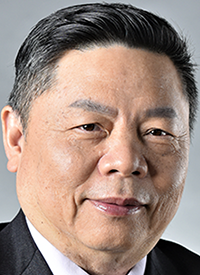Article
Consolidation Sugemalimab Provides Sustained PFS Benefit in Unresectable Stage III NSCLC
Author(s):
Sugemalimab appeared to be safe and effective when used as consolidation therapy for patients with unresectable stage III non–small cell lung cancer (NSCLC) who did not have disease progression following concurrent chemoradiation or sequential chemoradiation.
Yi-Long Wu, MD

Sugemalimab appeared to be safe and effective when used as consolidation therapy for patients with unresectable stage III non–small cell lung cancer (NSCLC) who did not have disease progression following concurrent chemoradiation or sequential chemoradiation, according to data from the final progression-free survival (PFS) analysis of the phase 3 GEMSTONE-301 trial (NCT03728556).
The data, which were presented during the first press briefing of the International Association for the Study of Lung Cancer (IASLC) 2022 World Conference on Lung Cancer, showed that at a median follow-up of 27.1 months in the sugemalimab arm and 23.5 months in the placebo arm, the PFS rates by blinded independent central review (BICR) were 60.4% and 71.4% (HR, 0.65; 95% CI, 0.50-0.84). The median PFS was 10.5 months (95% CI, 8.3-17.1) in the sugemalimab arm vs 6.2 months in the placebo arm. Moreover, the PFS rates were superior with sugemalimab at 12 (49.5% vs 32.3%, respectively), 24 (38.6% vs 23.1%), and 36 months (26.1% vs 0.0%).
When assessing PFS by chemoradiotherapy type, investigators reported rates of 73.3% and 92.7% following treatment with sugemalimab and placebo, respectively, after a median follow-up of 30.6 months and 27.8 months in both arms among patients treated with short course radiotherapy. The median PFS in the sugemalimab arm was 8.1 months (95% CI, 3.4-10.6) and 4.1 months (95% CI, 2.1-6.1) in the placebo arm. Additionally, the 12-month, 24-month, and 36-month PFS rates in both arms were 38.8% vs 12.7%, 30.5% vs 7.6%, and 18.1% vs 0.0%, respectively.
“Concurrent chemoradiotherapy followed by immunotherapy is the standard of care for patients with unresectable stage III lung NSCLC. [However], almost 50% did not receive concurrent chemoradiotherapy and only received sequenced chemoradiotherapy,” explained Yi-Long Wu, MD, tenured professor at Guangdong Provincial People’s Hospital, Guangdong Academy of Medical Sciences and Guangdong Lung Cancer Institute. “Additionally, only 45% had received concurrent chemoradiotherapy in Europe, 35% in Belgium, 55% in the Netherlands, and 45% in the United Kingdom.”
Among patients treated with concurrent chemoradiotherapy, the PFS rates were 53.8% and 61.2% after a median of 22.4 months and 20.0 months of follow up in the sugemalimab and placebo arms, respectively. The median PFS was 15.7 months (95% CI, 9.0-24.4) for the sugemalimab cohort and 8.3 months (95% CI, 5.8-24.8) for the placebo cohort. At 12, 24, and 36 months, the PFS rates across the sugemalimab and placebo groups were 54.8% vs 42.1%, 42.5% vs 34.0%, and 34.1% vs 0.0%, respectively.
The trial included a total of 381 patients who were randomized 2:1 to receive either intravenous sugemalimab at a dose of 1200 mg every 3 weeks or intravenous placebo every 3 weeks up to 24 months. The population included patients with stage III disease who hadn’t progressed following concurrent chemoradiotherapy or short course radiotherapy. Additional inclusion criteria included an ECOG performance status of 0 or 1 and no known sensitizing of EGFR, ALK, or ROS1 alterations. Patients were stratified based on performance status, type of chemoradiation therapy, and total radiotherapy dose.
The primary end point of the study was PFS by BICR, and secondary end points consisted of overall survival (OS), investigator-assessed PFS, overall response rate, duration of response, time to distant metastases, safety, and pharmacokinetics.
In terms of other findings, the OS rate in the sugemalimab arm was 33.3% after a median follow-up of 27.1 months and 42.9% after a median follow-up of 23.5 months (HR, 0.69; 95% CI, 0.49-0.97). The median OS was not reached (NR; 95% CI, 31.0-NR) in the sugemalimab arm vs 25.9 months (95% CI, 21.2-NR) in the placebo arm. The OS rates for the sugemalimab arm vs placebo at 12, 24, and 36 months were 86.0% vs 83.2%, 67.6% vs 55.0%, and 55.8% vs 29.5%, respectively.
Safety findings indicated that nearly all patients experienced treatment-emergent adverse events (TEAEs) in the sugemalimab and placebo arms (97.3% vs 96.0%, respectively). Serious TEAEs occurred in 78.4% and 27.8% of patients in the sugemalimab and placebo arms, respectively. Moreover, 31.0% of those in the sugemalimab cohort and 28.6% in the placebo cohort experienced grade 3 to 5 TEAEs. Permanent treatment discontinuation was necessary in 16.1% and 4.8% of patients, respectively, and 4.7% and 2.4% of patients died due to TEAEs. The most common grade 3 or higher TEAEs in the sugemalimab arm were immune-mediate lung disease, rash, hypothyroidism, and pneumonitis compared with pneumonitis and anemia in the control group.
Reference
Wu Yl. Sugemalimab vs placebo after cCRT or sCRT in pts with unresectable stage III NSCLC: final PFS analysis of a phase 3 study. Presented at 2022 World Conference on Lung Cancer; Vienna, Austria; August 6-9, 2022; abstract 968.








